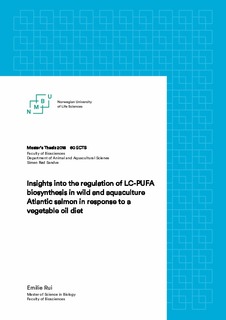| dc.description.abstract | The aim of this master thesis was to use transcriptomics to evaluate if lipid metabolism of wild and aquaculture salmon is different. In recent years, there has been extensive research on lipid metabolism in salmonids related to the changes in lipid content of their commercial diet over the past decade (Bell et al. 2003, Bell et al. 2004, Naylor et al. 2009, Sprague et al. 2016, Tacon and Metian 2013). Fish and other vertebrates are not able to produce poly-unsaturated fatty acids (PUFA) de novo, so they are required in the diet (Tocher et al. 2003). When Linolenic acid (LA) and alpha-Linolenic acid (ALA) are available, these essential fatty acids (EFAs) can then be converted to long-chain poly-unsaturated fatty acids (LC-PUFA), which are required for fish health, but also important for the health benefits of human salmon consumption. Because salmon is a very important source of LC-PUFA in humans, there is much interest in understanding the workings of the salmonid apparatus for endogenous LC-PUFA synthesis. Globally, half of all fish consumed comes from aquaculture and especially in Europe has the production from fisheries steadily declined while that of aquaculture grows (FAO 2016). As aquaculture is supplying an increasing amount of the total fish for human consumption, the industry is working on maintaining or improving the LC-PUFA content of fish products while also switching to more sustainable feeds (Sprague et al. 2016). The ability of the fish to endogenously synthesise LC-PUFA from EFAs is an important part of this objective. One aspect to understanding and perhaps improving LC-PUFA synthesis in aquaculture salmon, is to understand the difference between the diets of aquaculture and wild salmon (Bell et al. 1994), and how endogenous LC-PUFA synthesis is affected by these. In this project we set out to look for differences between aquaculture and wild salmon in the activity of their endogenous LC-PUFA synthesis in response to two industrial diets with different LC-PUFA content.
We hypothesised that wild salmon are more efficient than aquaculture salmon at converting fatty acid precursors to LC-PUFAs in response to a plant-based diet which is low in LC-PUFA, most notably the particularly healthy omega-3s docosahexaenoic acid (DHA) and eicosapentaenoic acid (EPA) (Gillard et al. 2018). This was based on the fact that wild salmon have a more variable supply of food and eat prey low in DHA and EPA in the river life-stage (Gillard et al. 2018), while aquaculture salmon are kept in environments with enormous surplus of nutrients. Hence, wild populations are experiencing natural selection favouring individuals with the ability to effectively regulate endogenous LC-PUFA synthesis upon insufficient dietary levels. Such selection pressure for maintaining a likely costly metabolic response has not been present for the past 15 or so generations of domestication in aquaculture salmon.
Genes required for the synthesis of LC-PUFA are found to be more highly expressed in salmon fed VO than those fed FO, regardless of fish strain. Further, aquaculture salmon have higher expression of a set of genes important to LC-PUFA synthesis. It appears that the response to a low LC-PUFA diet is more pronounced in aquaculture salmon than wild, contrary to our hypothesis. However, the evidence from transcriptomics is limited and there is some variation in the results over time. | nb_NO |

